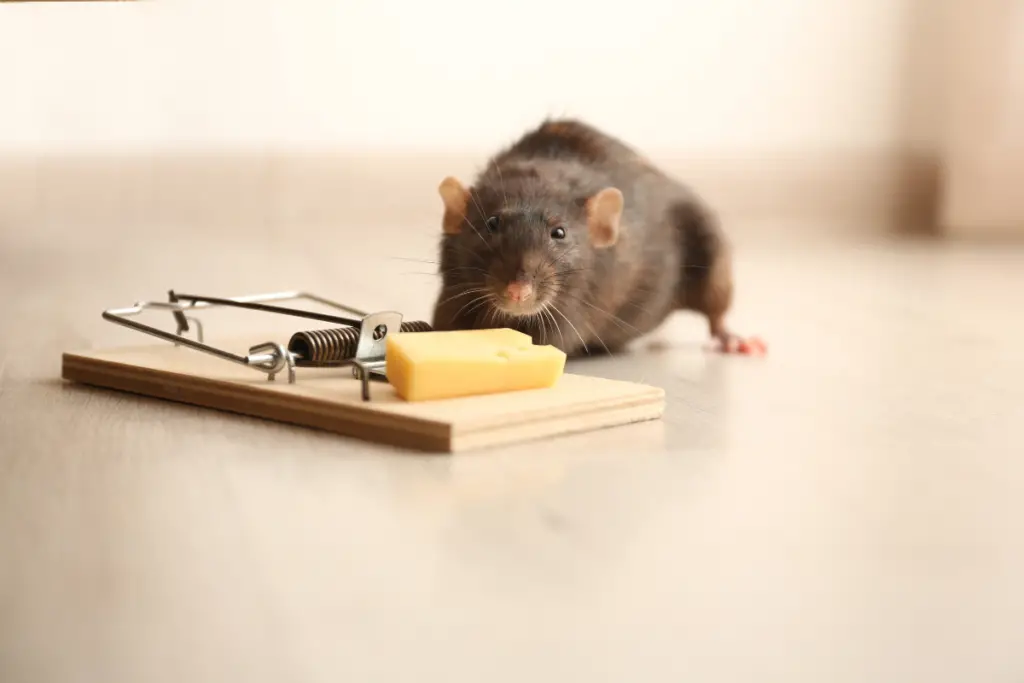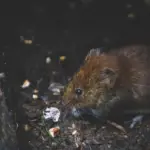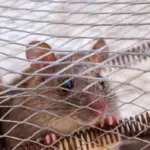When it comes to rat control, finding the right bait for your trap can be the key to success. Rats are known to be picky eaters, so choosing the right bait can make all the difference.
While peanut butter is a popular choice, there are other options that may work even better.
According to an article on Pest Control Gurus, some of the best rat trap baits include bacon, dried fruit, and pet food.
Bacon is a high-fat food that rats find irresistible, while dried fruit provides a sweet and chewy option.
Pet food, particularly wet food, can also be effective as rats are attracted to the strong scent.
It’s important to note that while these baits may work well, proper placement of the bait is also crucial for successful trapping.
Another factor to consider when choosing a bait is the type of trap being used. The Spruce recommends different baits for different types of traps.
For example, a snap trap may work well with a sticky bait such as peanut butter, while a live trap may require a bait that will last longer such as dried fruit or nuts.
It’s important to experiment with different baits and trap types to find what works best for your specific situation.

Table of Contents
Understanding Rat Behavior
Rats are known for their adaptability and survival instincts. They are intelligent creatures that have a keen sense of smell and taste.
Understanding their behavior can help in selecting the best bait for rat traps.
What Attracts Rats?
Rats are attracted to food, shelter, and water. They are opportunistic feeders and will eat almost anything.
They prefer to feed at night and will scavenge for food in garbage cans, compost piles, and pet food dishes.
Rats are also attracted to warm, dark, and quiet places to nest. They will seek shelter in attics, basements, and crawl spaces.
Rats need water to survive, and they will look for sources of water such as leaky pipes, standing water, and open containers.
What Type of Bait Do Rats Prefer?
Rats have a strong sense of smell and taste, and they are attracted to strong, pungent odors. The best bait for rat traps is something that smells and tastes good to rats.
Some of the most effective baits for rat traps include:
- Peanut butter: Rats love the sweet and salty taste of peanut butter. It is also easy to spread on the trap.
- Cheese: Contrary to popular belief, cheese is not the best bait for rat traps. However, some rats are attracted to the strong smell of cheese.
- Meat: Rats are omnivores and will eat meat if they can find it. Fresh meat, such as bacon or sausage, is an excellent bait for rat traps.
- Fruits and vegetables: Rats are attracted to the sweet smell of fruits and vegetables. Apples, bananas, and carrots are good options for bait.
It is important to note that rats can become bait-shy if they have had a negative experience with a trap.
It is best to change the bait regularly and to use multiple traps in different locations to increase the chances of catching a rat.
In conclusion, understanding rat behavior is essential in selecting the best bait for rat traps.
Rats are attracted to food, shelter, and water, and they prefer strong, pungent odors.
Peanut butter, meat, and fruits and vegetables are effective baits for rat traps.
Alternatively, try our recommended product below
Prices pulled from the Amazon Product Advertising API on:
Product prices and availability are accurate as of the date/time indicated and are subject to change. Any price and availability information displayed on [relevant Amazon Site(s), as applicable] at the time of purchase will apply to the purchase of this product.
Types of Rat Traps
When it comes to catching rats, there are several types of traps you can use. Each type has its advantages and disadvantages, so it’s important to choose the right one for your needs.
Here are the three most common types of rat traps:
Snap Traps
Snap traps are the classic type of rat trap. They consist of a wooden or plastic base with a metal bar that snaps down when triggered by the rat.
Snap traps are effective and inexpensive, but they can be difficult to set up properly. They also require regular cleaning and maintenance to keep them in good working order.
Prices pulled from the Amazon Product Advertising API on:
Product prices and availability are accurate as of the date/time indicated and are subject to change. Any price and availability information displayed on [relevant Amazon Site(s), as applicable] at the time of purchase will apply to the purchase of this product.
Glue Traps
Glue traps are another popular type of rat trap. They consist of a sticky adhesive that traps the rat when it steps on the trap.
Glue traps are easy to use and require no baiting, but they can be cruel and inhumane.
They also require careful handling to avoid getting stuck to the trap yourself.
Prices pulled from the Amazon Product Advertising API on:
Product prices and availability are accurate as of the date/time indicated and are subject to change. Any price and availability information displayed on [relevant Amazon Site(s), as applicable] at the time of purchase will apply to the purchase of this product.
Electronic Traps
Electronic traps are the newest type of rat trap on the market. They use an electric shock to kill the rat instantly when it enters the trap.
Electronic traps are easy to use and require no cleanup, but they can be expensive and require batteries or an electrical outlet.
When choosing a rat trap, it’s important to consider your needs and the needs of the rats you are trying to catch.
Prices pulled from the Amazon Product Advertising API on:
Product prices and availability are accurate as of the date/time indicated and are subject to change. Any price and availability information displayed on [relevant Amazon Site(s), as applicable] at the time of purchase will apply to the purchase of this product.
Snap traps are a good choice for those on a budget, while electronic traps are a good choice for those who want a more humane solution.
Glue traps should be used with caution and only as a last resort.
Choosing the Best Rat Trap Bait
When it comes to trapping rats, choosing the right bait is crucial. The bait you choose can make the difference between a successful catch and a wasted trap.
In this section, we’ll discuss the factors to consider when selecting the best rat trap bait and some of the top rat trap baits to consider.
Factors to Consider
Before selecting the best rat trap bait, it’s important to consider a few factors:
- Rat preferences: Rats have a strong sense of smell and taste, so it’s important to choose a bait that they find appealing.
- Location: Consider where you’ll be placing the trap. If it’s in a location with other food sources, you may need to choose a bait that’s particularly attractive to rats.
- Trap type: Different traps may require different types of bait. For example, a snap trap may require a solid bait that can be secured to the trigger, while a live trap may require a bait that can lure the rat inside without triggering the trap.
Top Rat Trap Baits
Here are some of the top rat trap baits to consider:
- Peanut butter: Peanut butter is a classic rat trap bait that’s both affordable and effective. Rats love the sweet, sticky texture of peanut butter, and it’s easy to apply to the trap trigger.
- Cheese: Cheese is another classic rat trap bait that can be effective. However, it’s important to note that not all rats are attracted to cheese, and it may not be the best choice in all situations.
- Meat: Rats are omnivores and enjoy a variety of meats, including bacon, sausage, and even canned cat food. However, meat can spoil quickly and may not be the best choice for traps that won’t be checked frequently.
- Fruits and vegetables: Rats also enjoy fruits and vegetables, such as apples, carrots, and celery. These can be a good choice for live traps or traps that won’t be checked frequently, as they won’t spoil as quickly as meat.
Ultimately, the best rat trap bait will depend on the situation and the preferences of the rats in your area. By considering the factors above and experimenting with different baits, you can increase your chances of a successful catch.
Tips for Using Rat Trap Baits
When using rat traps, it is important to choose the right bait to attract rats. However, proper placement and frequency of bait replacement are also crucial for successful trapping. Here are some tips for using rat trap baits:
Placement
Placing the bait in the right location is essential for attracting rats to the trap. The bait should be placed in the center of the trap, on the trigger plate.
This will ensure that the rat steps on the plate to reach the bait, triggering the trap.
Avoid placing the bait near the edges of the trap or dangling from the trap. Rats can easily snatch the bait without triggering the trap, rendering it ineffective.
Frequency of Bait Replacement
Rats are intelligent creatures and can easily detect stale or spoiled bait. It is important to replace the bait every 2-3 days to keep it fresh and attract rats.
If the bait is left for too long, it can become rancid and deter rats from approaching the trap. It is also important to clean the trap between bait replacements to remove any odors that may repel rats.
How to Dispose of Dead Rats
Once a rat is trapped, it is important to dispose of the dead rat properly to prevent the spread of disease. Wear gloves and use a plastic bag to remove the rat from the trap.
Dispose of the rat in a sealed trash bag and wash the trap with hot, soapy water. It is also important to disinfect the trap with a solution of 1 part bleach to 9 parts water to kill any bacteria or viruses.
Following these tips for using rat trap baits can increase the chances of successful trapping and help eliminate rat infestations.
Conclusion
In conclusion, selecting the right bait for a rat trap is crucial for achieving success in rodent control.
Peanut butter, cheese, and bacon are some of the most effective baits for rat traps.
However, it is essential to keep in mind that rats can be picky eaters and may not be attracted to the same bait every time.
Therefore, it is a good idea to rotate the bait occasionally to keep the rats interested.
When selecting a bait, it is also important to consider the type of trap being used.
For example, sticky traps require a bait with a strong odor, while snap traps require a bait that can be easily secured to the trigger.
Bait stations are another option that can be used to protect bait from weather and other pests.
It is also important to keep in mind that rats are intelligent creatures and can quickly learn to avoid traps.
Therefore, it is important to move traps to new locations and change the bait regularly to maintain effectiveness.
Overall, selecting the right bait for a rat trap requires some trial and error. However, by following these tips and experimenting with different baits, anyone can successfully control a rat infestation.
- How to Build a Planter Box for Bamboo: A Step-by-Step Guide

- Can Robotic Lawnmowers Handle Steep Slopes?

- Do You Need a Specific Lawn for a Robotic Lawnmower? Expert Advice

- Are Robotic Lawnmowers Safe for Pets and Children? Safety Features of Robotic Lawnmowers

- Why Use Robotic Lawnmowers? Advantages of Using a Robotic Lawnmower

- Is the GARDENA SILENO City 300 Cordless or Corded? A Clear Answer






































